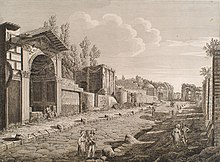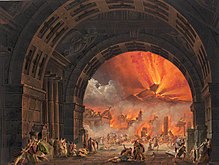The Last Day of Pompeii
| The Last Day of Pompeii | |
|---|---|
State Russian Museum, Saint Petersburg |
The Last Day of Pompeii is a large history painting by
Background

The Roman city of Pompeii, south of Naples, was under active excavation in the early 19th century, work having begun on the city and its neighbour Herculaneum in the middle of the previous century.[2] Artists were well aware of its potential as a subject. John Martin had painted The Destruction of Pompeii and Herculaneum in 1822 and others had sketched and produced engravings of the site.[1]
In 1823, Bryullov arrived in Rome with his brother

These sources coalesced into the work known as The Last Day of Pompeii

Subject and composition
The subject is the eruption of Mount Vesuvius in AD 79 that enveloped the city of Pompeii in volcanic ash killing most of its inhabitants. As a scene from the ancient world it was an appropriate subject for a history painting, then regarded as the highest genre of painting, and the magnitude of the event also made it suitable for a large canvas that would allow Bryullov to showcase all his skills.[4]
Bryullov said that he could only have completed the work with the example of Raphael's large and complex work The School of Athens (1509–1511) as his model,[11] and he used classical forms recognisable as those used by the Renaissance masters, but combined them with features found in Romantic painting, such as dramatic colouring, the use of chiaroscuro, and a high emotional content. Other works thought to have influenced Bryullov are Raphael's The Fire in the Borgo (1514–17) and Nicolas Poussin's The Plague at Ashdod (1630).[4][6]
He eschewed the coolness and flatness of the then-prevalent Neoclassicism in favour of excitement and vibrant colour, combined with a deep recession as a horse bolts into the depths of the painting, unseating its master. Nikolai Gogol commented: "His colouring is possibly brighter than it has ever been; his paints burn and hit you in the eye", but he was not the only one to note that the perfection of the classical figures contrasted with the wretchedness of their predicament.[4]
Bryullov filled the canvas with authentic detail from Pompeii that he had seen at the site and in the museum at Naples such as the artefacts carried by the figures and the authentic paving and kerb stones. Statues toppling from their pedestals bring additional drama and demonstrate the sublime power of nature over man, a common trope in
Reception
The painting took so long to finish that Demidov threatened to cancel its commission, but when it was first shown at Bryullov's studio in Italy on Via San Claudio in Rome, it received a rapturous response.
The reception was slightly cooler when it was displayed at the
It was the first Russian artwork to cause such an interest abroad, making Bryullov the first Russian painter to gain an international reputation.[8] Five foreign academies made him an honorary member and the quantity of positive reviews and critical comment was such that the Society for the Encouragement of Artists published a volume of them in Russian translation.[4]
When the painting arrived in Russia in August 1834, it was received with as much enthusiasm as it had been in Italy, according to Gogol as much by those with a refined taste as those who were ignorant of art.
After his great success with The Last Day of Pompeii, Bryullov was expected to produce similar large works of history, but most of his attempts remained unfinished and he was criticised for his Death of Ines de Castro, which was completed in only 17 days in 1834.[4][16] Instead he found success in portraits of the Russian elite including the royal family.[4][17]
Ownership
In 1834, Demidov presented the painting, for which he had paid 25,000
Gallery
-
The artist and his paintbox.[4]
-
It is thought that Countess Yuliya Samoylova and her daughters Giovannina and Amazilia were the models for these figures.[6]
-
Statues topple from their pedestals showing the sublime power of nature over man.[4]
-
A mother implores her son to flee as Pliny's mother had urged him to do.[18]
-
Stone work and pavements similar to those at Pompeii.[4]
-
The bolting horse and broken chariot lead the viewer deep into the painting where more chaos is occurring.[19]
References
- ^ a b Necropoli di Porta Ercolano, via dei Sepolcri, tombe monumentali, lato nord est – veduta. Pompei La fortuna visiva. Retrieved 22 November 2017.
- ^ Pompeii exhibition: a timeline of Pompeii and Herculaneum. Andrew Wallace-Hadrill & Joanne Berry, The Telegraph, 3 March 2013. Retrieved 26 November 2017.
- ISBN 1859952984
- ^ ISBN 9780300184372
- ^ Thermes de Pompéi. arachne.uni-koeln.de Retrieved 22 November 2017.
- ^ ISBN 978-1606061152
- ^ Leontyeva, p. 26.
- ^ ISBN 0140560068
- ^ Leontyeva, pp. 30–31.
- ^ Pompeian Entertainments. J. Paul Getty Museum. Retrieved 22 November 2017.
- ^ Leontyeva, p. 20.
- ^ "Salon de 1834. Peinture", L'Artiste, Vol. 7, No. 12 (1834), p. 136.
- ^ Leontyeva, p. 35.
- ^ "Tales of St Petersburg" by Orlando Figes in Frank Althaus and Mark Sutcliffe (2003) Petersburg Perspectives. St Petersburg: Fontanka with Booth-Clibborn Editions. pp. 91–105 (p. 97).
- ^ Leontyeva, p. 36.
- ^ The Death of Inês de Castro, Morganatic Wife of Don Pedro, Infant of Portugal. 1834. Russian Museum. Retrieved 26 November 2017.
- ^ Russian Painting During The Age of Romanticism. Dartmouth College. Retrieved 26 November 2017.
- ^ Leontyeva, p. 30.
- ^ Leontyeva, p. 33.
External links
![]() Media related to The Last Day of Pompeii (Karl Briullov) at Wikimedia Commons
Media related to The Last Day of Pompeii (Karl Briullov) at Wikimedia Commons

![The artist and his paintbox.[4]](http://upload.wikimedia.org/wikipedia/commons/thumb/6/6e/Detail_of_The_Last_Day_of_Pompeii_showing_the_artist.jpg/120px-Detail_of_The_Last_Day_of_Pompeii_showing_the_artist.jpg)
![It is thought that Countess Yuliya Samoylova and her daughters Giovannina and Amazilia were the models for these figures.[6]](http://upload.wikimedia.org/wikipedia/commons/thumb/d/d3/Detail_of_The_Last_Day_of_Pompeii.jpg/95px-Detail_of_The_Last_Day_of_Pompeii.jpg)
![Statues topple from their pedestals showing the sublime power of nature over man.[4]](http://upload.wikimedia.org/wikipedia/commons/thumb/6/62/Detail_of_The_Last_Day_of_Pompeii_%284%29.jpg/120px-Detail_of_The_Last_Day_of_Pompeii_%284%29.jpg)
![The classically modelled bodies of the horseman and the soldier are combined with Romantic depictions of the terror that may be created by the forces of nature in the figures of the old man and the horse.[4]](http://upload.wikimedia.org/wikipedia/commons/thumb/8/8f/Detail_of_The_Last_Day_of_Pompeii_%283%29.jpg/120px-Detail_of_The_Last_Day_of_Pompeii_%283%29.jpg)
![A mother implores her son to flee as Pliny's mother had urged him to do.[18]](http://upload.wikimedia.org/wikipedia/commons/thumb/5/53/Detail_of_The_Last_Day_of_Pompeii_%282%29.jpg/114px-Detail_of_The_Last_Day_of_Pompeii_%282%29.jpg)
![Stone work and pavements similar to those at Pompeii.[4]](http://upload.wikimedia.org/wikipedia/commons/thumb/6/67/Detail_of_The_Last_Day_of_Pompeii_%285%29.jpg/120px-Detail_of_The_Last_Day_of_Pompeii_%285%29.jpg)
![The bolting horse and broken chariot lead the viewer deep into the painting where more chaos is occurring.[19]](http://upload.wikimedia.org/wikipedia/commons/thumb/7/7f/Detail_of_The_Last_Day_of_Pompeii_%286%29.jpg/112px-Detail_of_The_Last_Day_of_Pompeii_%286%29.jpg)